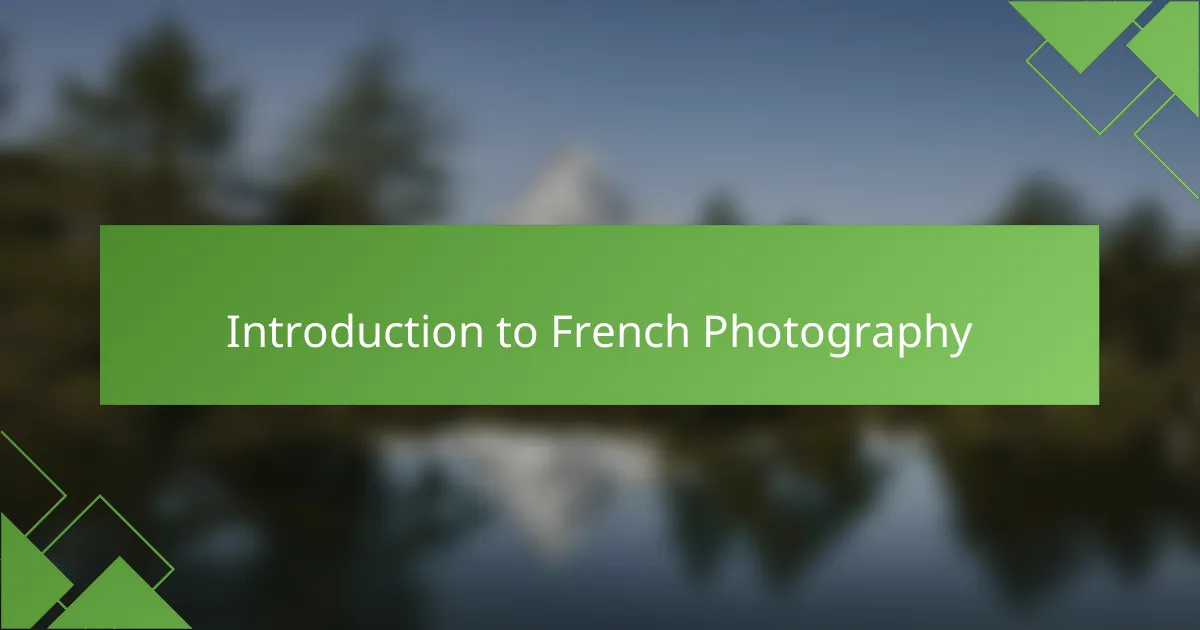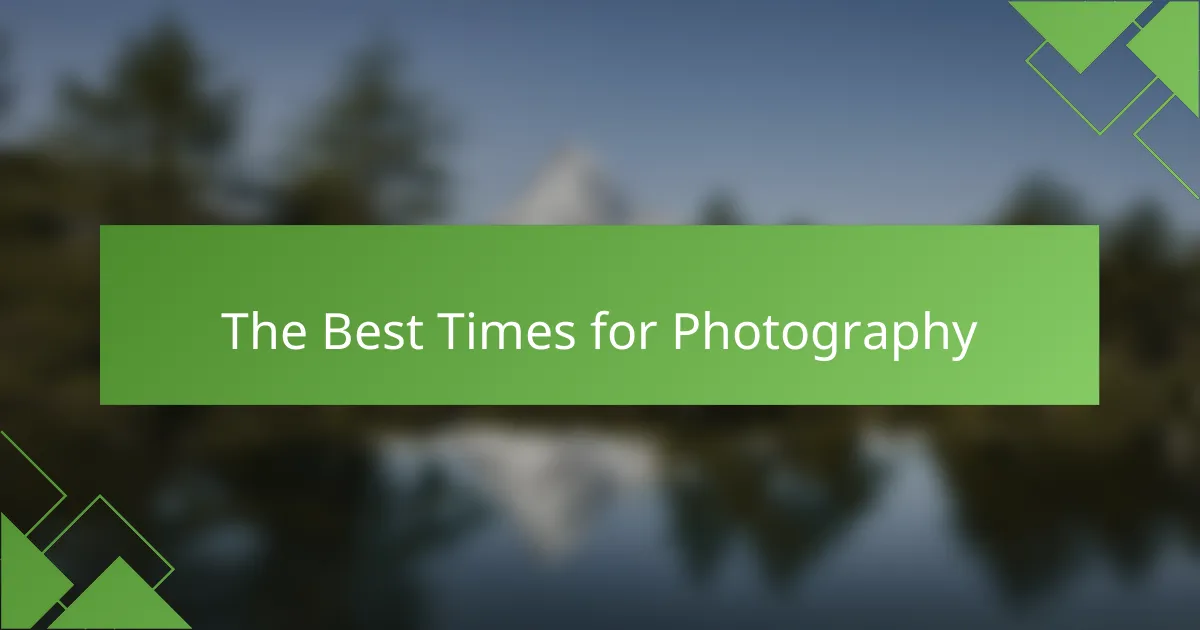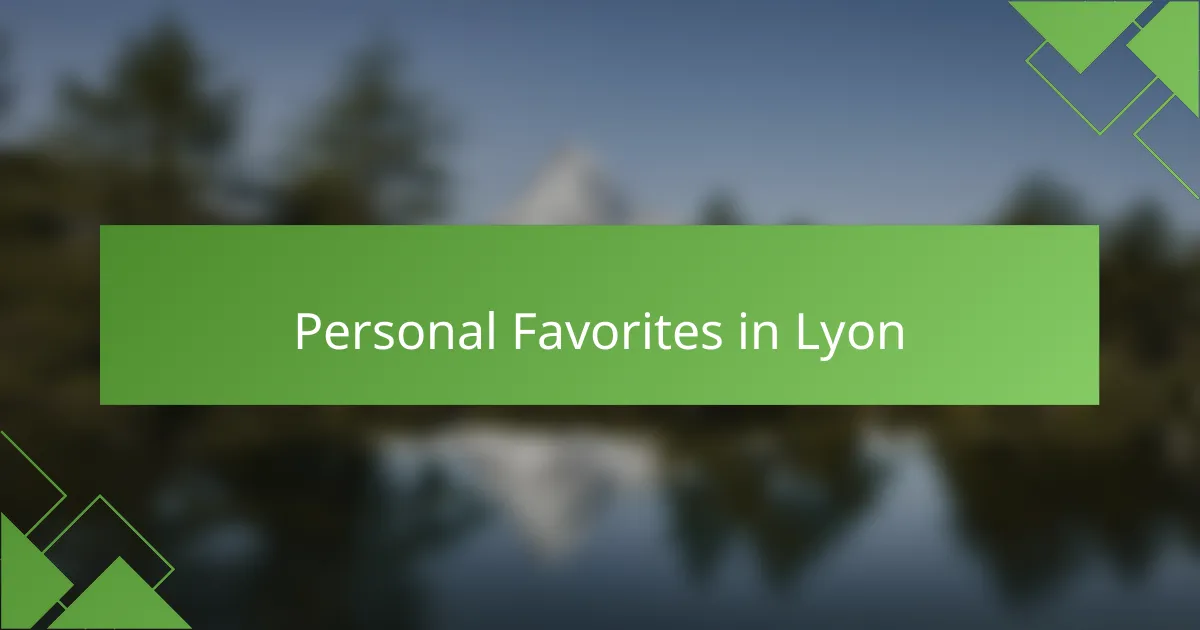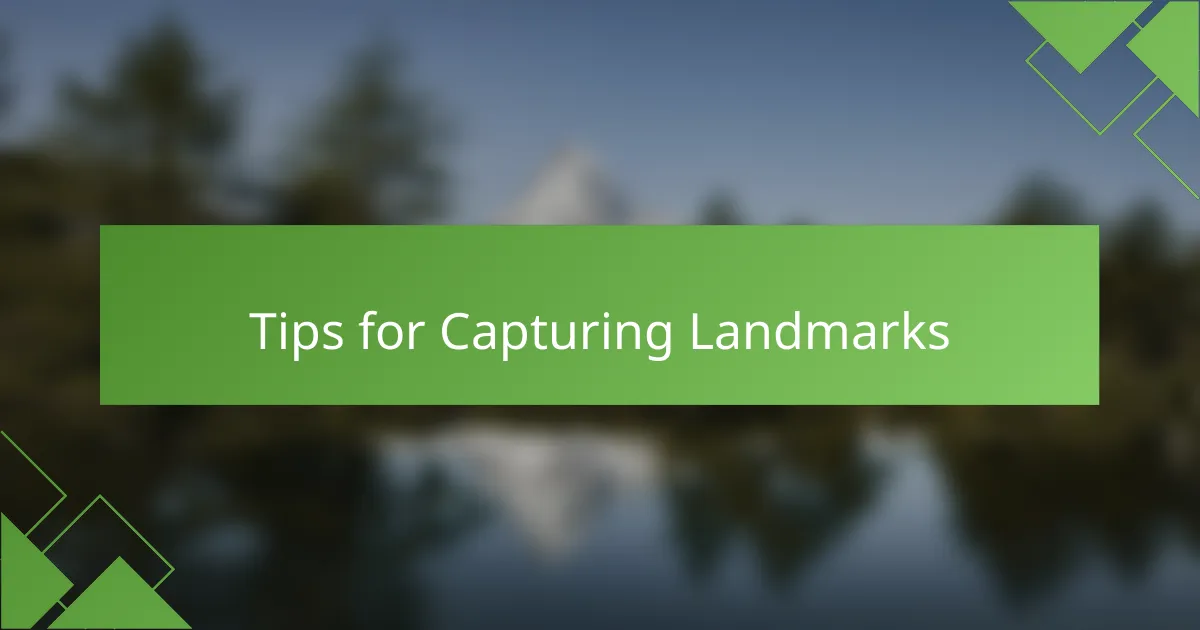Key takeaways
- French photography, influenced by pioneers like Henri Cartier-Bresson, emphasizes storytelling and evokes deep emotions through captured images.
- Lyon’s iconic landmarks, such as the Basilica of Notre-Dame de Fourvière and Parc de la Tête d’Or, offer rich photographic opportunities showcasing architecture and nature.
- Techniques like using leading lines, symmetry, and incorporating foreground elements enhance the framing of architectural subjects.
- Golden hours and seasonal changes provide the best lighting for photography, enriching visual storytelling and enhancing emotional resonance.

Introduction to French Photography
French photography holds a special place in my heart, as it captures the beauty of life and the essence of our surroundings. The rich history of French photographers, from the pioneers like Henri Cartier-Bresson to modern talents, has left an indelible mark on the world of visual arts. Each photograph tells a story, evoking emotions and providing glimpses into our shared experiences.
When I think about my own journey in photography, I remember the moments spent in quaint alleys and vibrant market squares. It’s not just about the landmarks, but about feeling the pulse of the city. Lyon, with its stunning architectural contrasts and lively atmosphere, has been a constant source of inspiration for me.
| Aspect | French Photography |
|---|---|
| History | Pioneered by artists like Henri Cartier-Bresson |
| Emotion | Evokes feelings through storytelling |
| Influence | Significant impact on global photography culture |
| Modern Day | Continues to evolve with innovative techniques |
![]()
Understanding Iconic Landmarks
When I think about iconic landmarks, I immediately envision how they encapsulate the essence of a city. In Lyon, there’s something magical about these structures; each one tells its own story, blending history and culture in an impressive way. For instance, when I stood before the Basilica of Notre-Dame de Fourvière, I was overwhelmed by its intricate architecture and the panoramic views of the city it offered.
As I wandered the narrow, winding streets of Vieux Lyon, I felt an intimate connection to the past. The Fourvière Hill, with its stunning basilica, appeared almost like a watchful guardian over the city. The colors, the lights, and even the sounds gave life to my photographs, making every click of the shutter feel profound.
Here’s a quick overview of some iconic landmarks in Lyon that every photographer should consider:
- Basilica of Notre-Dame de Fourvière: A stunning [censured] with impressive architecture and breathtaking views.
- Parc de la Tête d’Or: A beautiful urban park with a serene lake and lush gardens.
- The Traboules: Hidden passageways that showcase Lyon’s rich historical tapestry.
- The Lyon Opera House: A striking building that merges contemporary glass with classical design.
- The Croix-Rousse Hill: Offering unique perspectives of the city and vibrant street art.
Capturing these landmarks is not just about photography; it’s about embracing the emotions and stories they represent.

Techniques for Framing Architecture
When it comes to framing architecture, I find that perspective is everything. Using leading lines, like the ones created by roads or pathways, draws the viewer’s eye directly to the structure. I remember standing in front of the Basilica of Notre-Dame de Fourvière, adjusting my angle to capture the way the stairs invited the viewer up to the stunning facade.
Another technique I often employ is to look for symmetry. Buildings like the Palais des Congrès de Lyon showcase such balanced designs. It’s fascinating how capturing a perfectly symmetrical shot can evoke a sense of harmony and order in an otherwise bustling city. Each time I press the shutter, I’m reminded of the connection between the timeless architecture and the dynamic energy of Lyon.
Finally, I love experimenting with depth by incorporating elements in the foreground. For instance, framing the Lyon Confluence with bustling café tables in the foreground adds life to the shot. It creates a narrative that resonates with the vibrant atmosphere of the city.
| Technique | Description |
|---|---|
| Leading Lines | Utilize natural lines to guide the viewer’s gaze towards the architecture. |
| Symmetry | Focus on balanced designs for a harmonious visual effect. |
| Foreground Elements | Incorporate elements in the front to add context and depth to the scene. |

The Best Times for Photography
The best times for photography in Lyon often align with the golden hours—early morning and late afternoon. The soft, warm light during these periods casts enchanting shadows on the city’s iconic landmarks. I remember the first time I captured the Basilica of Notre-Dame de Fourvière at dawn; the gentle light made the intricate details pop, creating a scene that felt almost ethereal. Isn’t it incredible how a moment can change with the light?
Additionally, I’ve found that late spring and early fall offer stunning opportunities as the colors of the foliage add vibrancy to the backdrop of historical architecture. When I strolled through Parc de la Tête d’Or in early October, the autumn leaves created a stunning contrast against the classical structures. The serene setting paired with the striking colors made every photograph I took feel alive with emotion.
Don’t overlook the magic of nighttime photography, either. Lyon is known for its Festival of Lights, and capturing the illuminated landmarks is an experience like no other. I remember one evening at the Lyon Opera House, where the lights danced around the glass and stone. The reflection in the surrounding puddles after a light rain added a captivating layer to my visuals. How often do you get to witness the city shine in its own right?

Personal Favorites in Lyon
When I think of my personal favorites in Lyon, the Basilica of Notre-Dame de Fourvière comes to mind first. The moment I stood before its intricate façade, illuminated by the golden sun, I felt an overwhelming sense of history and artistry that is difficult to describe. It’s not just the stunning architecture; it’s the way the city stretches out beneath it, inviting me to capture both the [censured] and its expansive view.
Another spot that always steals my breath is Parc de la Tête d’Or. I remember a lazy afternoon spent wandering its paths, camera in hand, the vibrant colors of the flowers contrasting beautifully against the greenery. Every corner offers another opportunity for that perfect shot, whether it’s the shimmering lake, the bustling rose garden, or the charming little animals roaming the grounds.
- Basilica of Notre-Dame de Fourvière: A blend of history and panoramic views.
- Parc de la Tête d’Or: A paradise for nature lovers and photographers alike.
- Place des Terreaux: The lively square filled with stunning fountains and surrounding architecture.
- Rue de la République: A bustling street great for capturing urban life and street style.
- Vieux Lyon: A charming neighborhood where every alley holds a story, perfect for capturing local culture.

Tips for Capturing Landmarks
Capturing iconic landmarks can be a delightful challenge. I often find that the best time to photograph is during the golden hour, just after sunrise or before sunset. The soft, warm light adds depth and richness to your shots, making the monuments truly come to life.
Another tip I’d recommend is to look for unique angles. When I was photographing the Basilique Notre-Dame de Fourvière, I decided to explore the surrounding streets and found an unexpected vantage point. The result was a striking image that many people commented on, appreciating the fresh perspective.
Lastly, consider incorporating elements of the local culture. During my shoots in Lyon, I try to include people or everyday activities to create a connection between the landmark and the vibrant life around it. This not only brings context to your photographs but also evokes emotion and tells a compelling story.
| Tip | Explanation |
|---|---|
| Time of Day | Golden hour provides the best light for capturing landmarks. |
| Unique Angles | Exploring different perspectives can lead to striking images. |
| Cultural Context | Incorporating local life adds depth and emotion to your photography. |